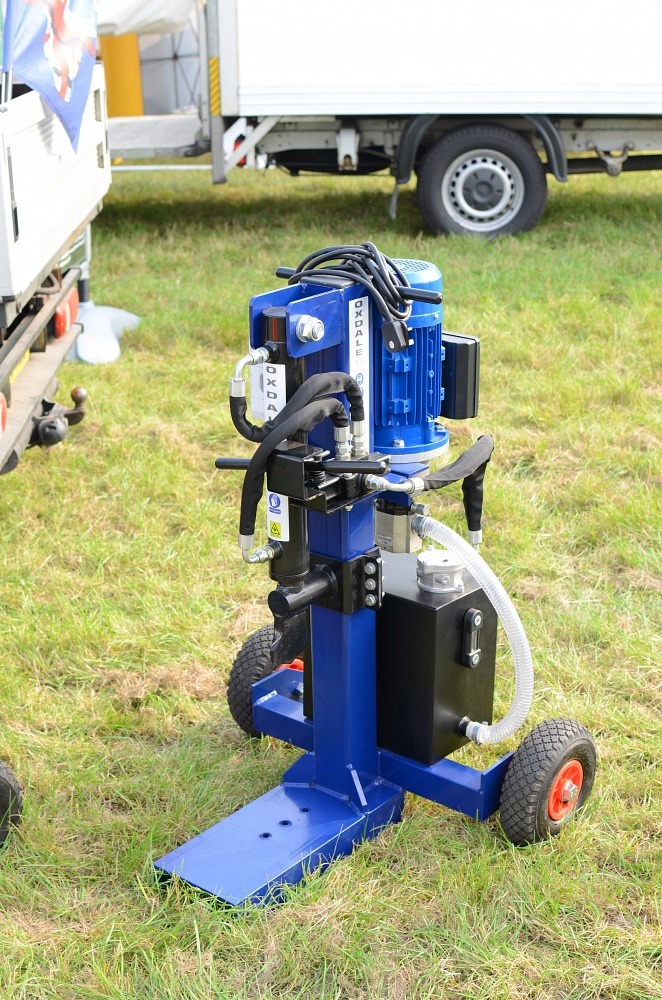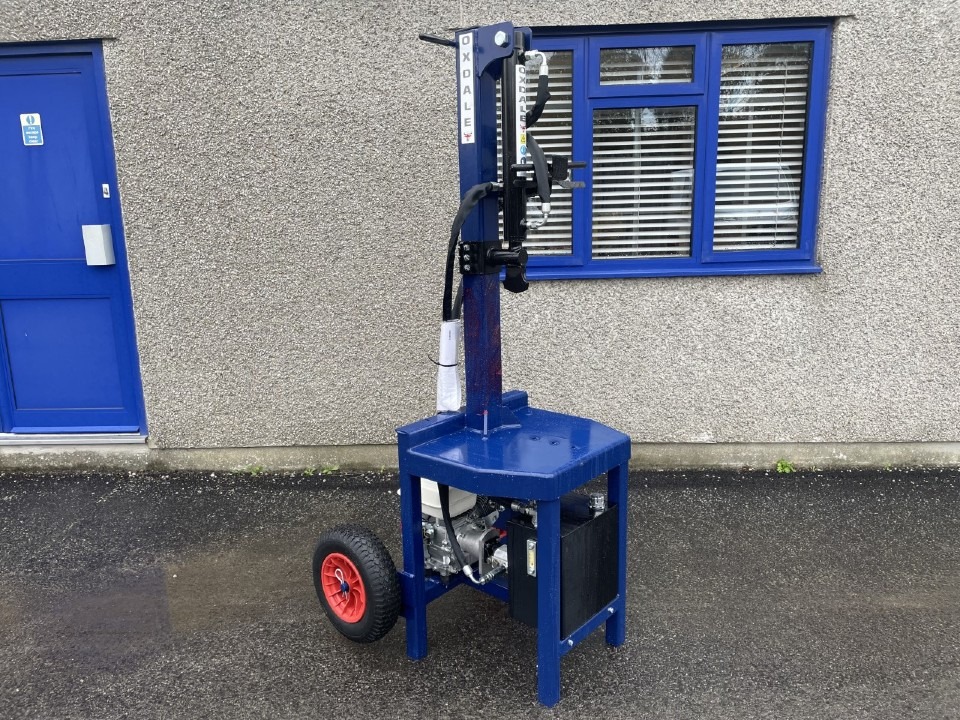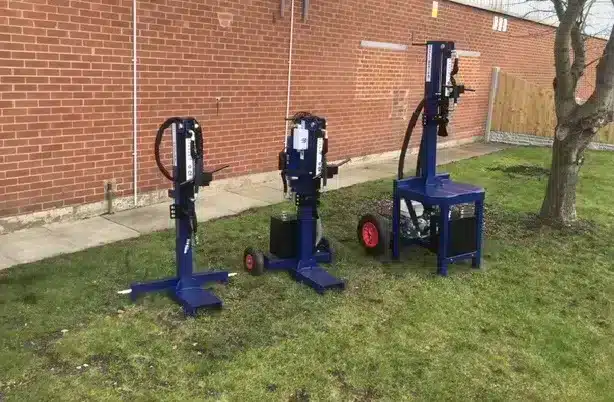
British Built Machinery That’s Made to Last
BY OXDALE PRODUCTS
Choosing the right log splitter can be a daunting task. With so many options available, it’s easy to feel overwhelmed.
This guide aims to simplify the process. We’ll explore the different types of splitters, including tractor, electric, and petrol models.
We’ll also delve into key features to consider. From splitting force to cycle time, we’ll cover it all.
Whether you’re a homeowner, gardener, or professional landscaper, this guide is for you. It’s designed to help you make an informed decision.
So, if you’re in the market for a log splitter, keep reading. This guide will provide you with the knowledge you need to choose the best machine for your needs.
Wood splitters come in various types. Each type has its unique features and benefits.
The four main types are manual, electric, petrol, and tractor-mounted. Your choice will depend on your specific needs and preferences.
For instance, if you value portability and power, a petrol splitter might be ideal. On the other hand, if you prefer quiet operation and have access to an electrical outlet, an electric model could be the best fit.
Let’s delve deeper into each type:
Manual splitters are the simplest type. They require physical effort to operate.
These models are typically lightweight and portable. They’re ideal for small jobs and occasional use.
However, they may not be the best choice for larger logs or frequent use. The physical effort required can be tiring.
Electric log splitters are a popular choice. They offer a balance of power and convenience. They are particularly effective for those looking to split wood efficiently and safely.
These models operate quietly and don’t emit fumes. They’re suitable for indoor or residential use.
However, they require access to an electrical outlet. This can limit their portability.

Petrol log splitters are the most powerful. They’re designed for heavy-duty tasks.
These models can handle larger logs with ease. They’re also highly portable, as they don’t require an electrical outlet. Splitting firewood with a petrol machine ensures you can chop wood into suitable logs efficiently.
However, they’re louder and emit fumes. They may not be suitable for indoor use.

Tractor log splitters leverage the power of a tractor. They’re ideal for heavy-duty splitting tasks. Splitting logs with these tools becomes much easier and more efficient. The more power you have, the more likely the machine is to cope with different types of soft or hardwood logs.
These models are typically robust and efficient. They’re perfect for large volumes of wood.
However, they require a tractor for operation. While this can limit their use to certain environments, compact tractors are small and maneuverable and therefore are a great pairing.

When shopping for a wood splitter, several key features should guide your decision.
These include the splitting force, operation mode, cycle time, and portability. The construction of the machine is also crucial. Additionally, consider the quality and durability of the splitting wedge used in the log splitter.
Let’s explore these features in more detail:
The splitting force is measured in tons. It determines the size and hardness of the wood the machine can handle, ensuring it can effectively split logs of varying sizes and diameters.
For small logs and softwoods, a lower-tonnage machine may suffice. For larger logs or hardwoods, you’ll need a higher-tonnage model.
Remember, a splitter with more force than you need can be overkill. It may also consume more energy or fuel.
These log splitters can operate in horizontal or vertical modes. Some models offer both options.
Horizontal splitters are common. They’re suitable for logs that can be easily lifted onto the machine.
Vertical splitters are ideal for larger logs. They allow you to split the log without lifting it onto the machine. A vertical log splitter provides higher splitting pressure and powerful capabilities for logs up to a certain length and diameter, making it a robust and space-saving option for firewood preparation.
The cycle time affects your productivity. It’s the time it takes for the ram to split a log and return to its starting position.
A shorter cycle time means you can split more logs in less time. However, faster isn’t always better. A very fast cycle time can compromise safety. Look for a machine that has a good cycle time with fast and efficient results, whilst incorporating safety features that allows you to process large quantities of wood whether that be for wood fires, wood stove or other applications such as biomass.
Consider the portability. Models with wheels or towable designs are easier to move around.
The construction is also important. Look for durable materials like steel. A well-constructed splitting machine will withstand heavy use and last longer.
Safety should be a top priority.
Maintenance is also crucial for the longevity and performance of the machine.
Let’s delve into these aspects:
A good log splitter should have safety features. These include automatic shut-off, hands-free operation, and protective guards.
Automatic shut-off stops the machine if a problem is detected. This can prevent accidents and damage to the splitter.
Hands-free operation allows you to control the machine without placing your hands near the splitting area. This reduces the risk of injury.
Protective guards shield you from flying wood chips and debris. They also prevent accidental contact with the splitting area.
Regular maintenance is key to longevity. This includes checking for leaks, rust, and wear.
The construction materials also affect durability. A machine with a steel frame, for example, is likely to last longer.
Remember to consider the availability of replacement parts. A machine that’s easy to service will save you time and money in the long run.
Finally, always read the manual. Understanding the machine’s limitations can prevent damage and prolong its life.
When buying a log spiltting machine, you have the option of purchasing a new or used model.
Each option has its pros and cons, which we’ll explore in the following sections:
Buying a new log splitter has several advantages.
Firstly, new models come with a warranty. This provides peace of mind and protection against defects.
Secondly, new splitters are less likely to require immediate maintenance or repairs. This can save you time and effort.
The Oxdale range of Log Splitters come with warranty and the long-term protection of spare parts. Although, you’ll not likely need them as the machines are built to last here in the UK.
If you’re considering a used splitter, there are ways to find reliable options.
Online marketplaces are a good starting point. They often have a wide range of used log splitters for sale.
Local dealers may also have used models. They can provide valuable advice and after-sales support.
Finding the right log splitter for your needs can be a challenge.
However, there are several places where you can find splitters for sale.
These include online marketplaces, local dealers, and even some home improvement stores.
Online marketplaces like eBay and Amazon often have a wide range of splitters for sale.
You can filter by type, brand, price, and more.
Local dealers are another good option. They can provide expert advice and after-sales support.
Remember to compare prices and features from multiple sellers before making a decision.
It’s not just about finding splitters for sale.
You need to consider your specific needs, the splitter’s features, and your budget.

British Built Machinery That’s Made to Last